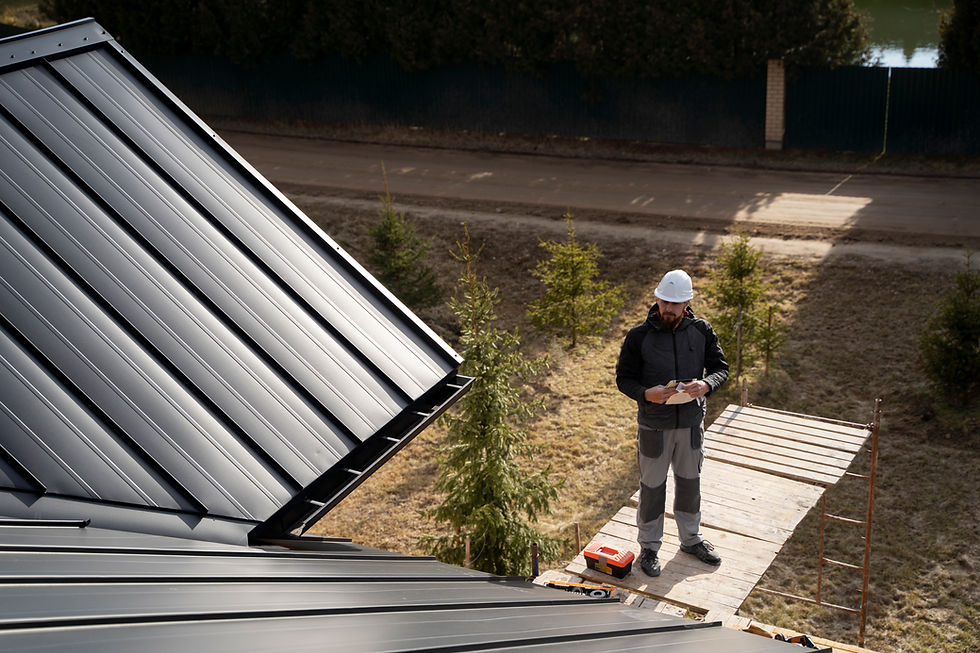Why Flat Roofs Rather Than Commercial Roofing Materials Are Better Choices for Buildings
- John Shaw
- Mar 11
- 3 min read
When considering the best roofing option for a commercial or industrial property, the choice often comes down to traditional commercial roofing materials or flat roofing solutions. Over the years, flat roofs have gained popularity due to their cost-effectiveness, durability, and efficiency. Whether you're planning a new construction project or upgrading an existing building, opting for flat roofing could be the most practical decision. This article explores why flat roofs are a superior choice compared to conventional commercial roofing materials.
Cost-Effectiveness and Affordability
One of the most significant advantages of flat roofing is its affordability. Unlike pitched or sloped roofs, which require extensive materials and complex installation processes, flat roofing involves fewer materials and less labour. This makes it a cost-effective option, especially for large commercial buildings. Many businesses prefer flat roofs as they help reduce initial costs while still providing excellent protection.
Additionally, maintenance and repair costs for flat roofs are generally lower. Traditional roofing materials, such as metal sheets or tiles, may require expensive repairs over time due to wear and tear. In contrast, flat roofs can be quickly repaired with materials like rubber roofing, which offers longevity and ease of maintenance.
Durability and Longevity
Flat roofing systems are designed to withstand harsh weather conditions. Modern roofing services offer durable materials such as EPDM (ethylene propylene diene terpolymer) and TPO (thermoplastic olefin), which provide excellent resistance against UV rays, extreme temperatures, and heavy rainfall.
Rubber roofing, in particular, is known for its resilience and flexibility. It can expand and contract with temperature changes, reducing the risk of cracks and leaks. This makes it a preferred choice for commercial buildings looking for long-lasting roofing solutions. When installed correctly by a professional roofing service, flat roofing can last for decades with minimal upkeep.
Energy Efficiency and Sustainability
Energy efficiency is a crucial factor when selecting a roofing system for any building. Flat roofs are known for their ability to improve energy efficiency by reducing heat absorption. Many flat roofing materials, including rubber roofing, have reflective properties that help maintain indoor temperatures, reducing reliance on heating and cooling systems.
Furthermore, flat roofs allow for the installation of green roofing solutions, such as solar panels and rooftop gardens. These eco-friendly additions not only enhance energy efficiency but also contribute to a sustainable environment. Businesses aiming to lower their carbon footprint can benefit from flat roofing systems that support renewable energy sources.
Space Utilisation and Functional Benefits
Unlike traditional sloped roofs, flat roofing provides additional usable space. Many commercial property owners take advantage of flat roofs to create rooftop terraces, storage areas, or even HVAC system placements. This maximises the building's space without compromising on structural integrity.
Moreover, businesses that require frequent maintenance of rooftop equipment find flat roofs much easier to access compared to pitched roofs. The ease of movement reduces the risk of workplace accidents and enhances the efficiency of maintenance services.

Ease of Installation and Maintenance
Compared to conventional commercial roofing materials, flat roofing is easier and quicker to install. Professional roofing services can complete a flat roof installation in a shorter time, reducing disruption to business operations.
Maintenance is also straightforward with flat roofs. Regular inspections and minor repairs can be done with minimal effort, ensuring that the roofing system remains in optimal condition for years. Rubber roofing, in particular, requires little upkeep while offering superior protection against leaks and weather-related damage.
Versatility in Design and Aesthetic Appeal
Flat roofs provide a sleek and modern aesthetic, making them a popular choice for contemporary commercial buildings. They offer architectural versatility, allowing businesses to customise their roofing designs to suit their specific needs.
Additionally, flat roofing can be combined with various coatings and sealants to enhance its durability and visual appeal. With options like rubber roofing, businesses can choose a solution that not only looks great but also provides long-term functionality.
Conclusion
When weighing the benefits of flat roofs against traditional commercial roofing materials, it’s clear that flat roofing is the superior choice for many businesses. With advantages such as cost-effectiveness, durability, energy efficiency, and versatility, it offers a practical and sustainable solution for commercial properties.
If you’re considering upgrading your building’s roof, consulting a professional roofing service can help you determine the best flat roofing system for your needs. Whether it’s rubber roofing or another high-quality material, investing in flat roofing ensures long-term benefits for your business. Make the smart choice today and experience the advantages of flat roofing for your commercial property.



Comments